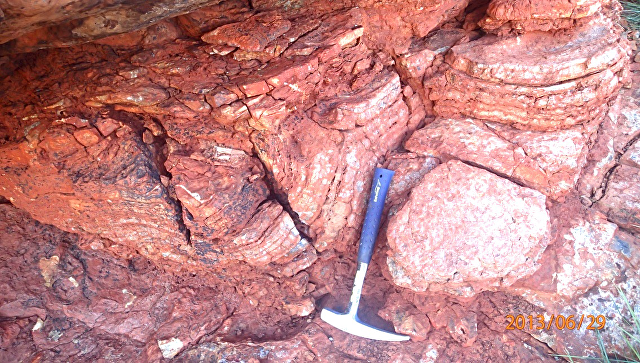© Djokic et al. / Nature Communications 2017
MOSCOW, Dec 19 - RIA Novosti. Geologists have proven that fragments of graphite formed at the bottom of the primary ocean three and a half billion years ago represent traces of the existence of archaea - one of the two main types of microbes on Earth, reports the journal PNAS .
Earth before the beginning of time
The first organisms appeared on Earth during the Archaean era, but there is no generally accepted point of view about when and how it happened. So far there have been only a few fossil evidence that microbes existed in the primary ocean about 3.4 billion years ago, but many scientists believe that life could have originated much earlier.
In 2015, Japanese geologists who studied samples of graphite from the Isua formation, which was 3.7 billion years ago in the territory of Greenland, found hints of existence of life already at that time. The first unambiguous evidence for this was discovered last year, and a year earlier, scientists discovered in Australia that organisms existed on Earth even earlier - four billion years ago.
Many geologists, as Wally notes, fundamentally disagree with such estimates and believe that this happened much later - 2.5-3 billion years ago. They often criticize such finds, noting that deposits of graphite and other supposedly biogenic rocks could have formed without the participation of microbes, and traces of bacteria and archaea could draw the imagination of researchers.
Wally and his colleagues tried to prove that skeptics are wrong. To do this, they studied the isotopic and chemical composition of graphite deposits found in Pilbara in western Australia three decades ago.
These deposits formed about 3.5 billion years ago in the shallow waters of the primary ocean, as evidenced by the rocks surrounding the graphite. They are distinguished by filamentary structures, similar to a multitude of microbes, "glued together" with each other.
"Talking" isotopes
Geologists drew attention to a well-known fact: living organisms and their remains are characterized by a slightly different proportion of carbon isotopes than for deposits of non-living organics. This makes it possible to unambiguously establish the origin of these or those sedimentary rocks.
© PNAS
Remains of an ancient archaea found in western Australia
Guided by this idea, scientists cut off small layers of pieces of graphite found in Pilbara, and enlightened them with a particle accelerator. So they were able to accurately calculate the number of carbon atoms-12 and carbon-13 in supposed "bacteria" and surrounding matter of inorganic origin.
"The boundaries between microbes and inorganic deposits ideally coincided with the location of the zones with different proportions of carbon isotopes.If these structures are not of biogenic origin, such differences can not be explained.The proportions of carbon-13 and carbon-12 in these remains ideally correspond to that, how the metabolism of microbes proceeds and how they live as a whole, "- continues Wally.
The same measurements, as the geologist notes, pointed out for the first time that scientists are dealing not with the first bacteria, but with archaea - distant relatives of modern staphylococci, Escherichia coli and other representatives of the microworld, which are slightly closer to multicellular creatures than other microbes. Moreover, the relatively low share of carbon-13 in the remains indicates that these microbes were fed with methane, which was then abundant in the atmosphere.
This discovery pushes back the appearance of the Archaean for nearly 800 million years - before scientists believed that they appeared much later than bacteria, about 2.7 billion years ago. So, says Wally, life evolved much faster than imagined, and could appear almost simultaneously with the birth of the planet.






No comments:
Post a Comment